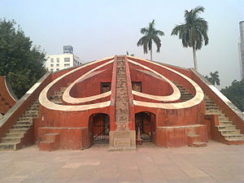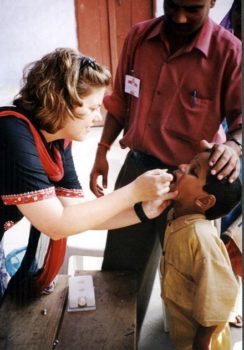This was originally published at Scientific American
Just a few weeks ago, I flew into India to join other new media specialists and journalists with the International Reporting Project to examine issues of child survival and health. (Before I continue, I simply must extend thanks to the Bill and Melinda Gates Foundation for providing a portion of the IRP funding to make this trip possible, the School of Integrative Biology at UIUC for supporting my participation in the project and GoPro Cameras for outfitting me with a Hero3 for documentation purposes.)
I have talked to many many people who have experienced India, I’ve read numerous books (fiction and non-fiction), and watched many documentaries, TV shows, and fictional movies about India, but knew that the experience of visiting would be something valuable. I was warned of the approximately “five people per square foot” population density in Mumbai, of the smell–a persistent sewer/trash odor, the pollution, the noise, the dogs, cattle, and goats, and the widespread extreme poverty. I discovered that the southern port city of India in Maharashtra State where we first landed, formerly known as Bombay, to be all that and even more. It was humid and warm during our visit, but actually in a relatively cool and dry streak, at least for India. The city, as I was exaggeratively informed by John Schidlovsky, founder and director of the IRP, “was built on mold” and with my allergy to mold so severe that I carry an epipen, I found myself taking more than the recommended dose of allergy meds just to breathe, each day grateful it wasn’t the rainy season. Thankfully, we eventually traveled north to cooler, drier, and less moldy climes to a rural area outside Nagpur and later to New Delhi.
Throughout most of India, I found myself delighted at the fact that women still wear colorful sarees on a daily basis, not yet succumbing to western trends, and impressed that men and boys generally wear button-down shirts, slacks, and nice shoes everyday, no matter their income level or age (try convincing a young boy to do that in America day to day–no way!)
 <–Niramaya Health Foundation
<–Niramaya Health FoundationIf you have seen the movie “Slumdog Millionaire”, it begins in Mumbai, in one of the largest slums located near the airport and situated right at the largest dumping ground in India. This area was our first stop in order to visit the Niramaya project drop-in health center. We toured the slums and received an overview of healthcare and educational awareness work Niramaya does in the community.






 <–Niramaya Health Foundation
<–Niramaya Health Foundation




Inside the International Space Station Control Room
I have attended a few NASA events, including the last shuttle launch and the launch of MAVEN. I visited Johnson Space Center in May 2013, tweeting images and thoughts from my visit. The image above was seen by Jennifer Welsh at Business Insider and included in a post, with my permission.
“Joanne Manaster, a biologist at the University of Illinois-Urbana, tweeted this image of the mission control room that runs the International Space Station.
In the picture, you can see a video link into the station, the video feed from an outer camera on the station, and the station’s route, which you can also find online. Look at all those screens — four each!
You can see the Flight Director, who monitors the technical aspects of the space station’s flight in real time; the CAPCOM, who is the capsule communicator that talks directly to the astronauts on the space station; and the MOD, the mission operations dictorate, who plans, directs, manages, and implements overall mission operations.“
I also saw a retired Soyuz capsule, a mock up of the International Space Station used to train astronauts and some mock-ups of the new Orion capsule that will be our next vehicle to take humans back and forth to space, and with any luck, they will also go to Mars.
If you ever have an opportunity to go to a NASA Social, I highly recommend giving it a chance. It will help you look at our space program with a more informed eye, and every space news story will come alive in your mind.
10 years ago Social Media, Space, Travel, Uncategorized • Tags: Business Insider, Control Room, Houston, International Space Station, ISS, Joanne Manaster, Johnson Space Center, NASA, NASA Social, Orion